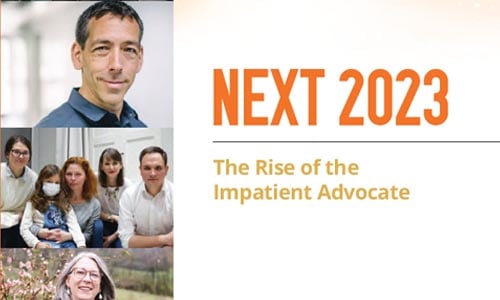Euan Ashley Talks About the Need for Speed in Rare Disease Diagnosis — The 2023 NEXT Report
June 20, 2023
 Euan Ashley and his team set a Guinness World Record for the fastest DNA sequencing — 5 hours and 2 minutes, and he believes they can get there even faster. They aren’t just seeing results in a lab either. The team was able to use this technology to diagnose a 3-month old with seizures with Poirier–Bienvenu neurodevelopmental syndrome in just 8 hours and 25 minutes. The syndrome is characterized by early-onset seizures caused by a mutation to the CSNK2B gene. The quick diagnosis allowed the infant’s care team to set aside the array of treatments they had prepared and instead provide disease-specific counseling and specialized treatment to manage the seizures. Genetic testing did not uncover this diagnosis because the CSNK2B gene was not part of the screening.
Euan Ashley and his team set a Guinness World Record for the fastest DNA sequencing — 5 hours and 2 minutes, and he believes they can get there even faster. They aren’t just seeing results in a lab either. The team was able to use this technology to diagnose a 3-month old with seizures with Poirier–Bienvenu neurodevelopmental syndrome in just 8 hours and 25 minutes. The syndrome is characterized by early-onset seizures caused by a mutation to the CSNK2B gene. The quick diagnosis allowed the infant’s care team to set aside the array of treatments they had prepared and instead provide disease-specific counseling and specialized treatment to manage the seizures. Genetic testing did not uncover this diagnosis because the CSNK2B gene was not part of the screening.
Read an excerpt from the 2023 NEXT Report about Ashley’s efforts:
Euan Ashley and his colleagues at Stanford Medicine in 2022 set a Guinness World Record for the fastest DNA sequencing technique by sequencing a human genome in just 5 hours and 2 minutes. The time to sequence and diagnose the patient totaled seven hours and 18 minutes, breaking the record previously held by Rady Children’s Institute.
Ashley, professor of medicine, genetics, and biomedical data science at Stanford, used a new, ultra-rapid genome sequencing approach he and colleagues developed to diagnose rare genetic diseases in an average of eight hours. The scientists used this approach to sequence 12 genomes over a six-month period and were able to diagnose five of those patients. On average, it took eight hours to deliver a diagnosis.
Ashley and his team worked with colleagues at Oxford Nanopore Technologies, who built what was described as a “mega-machine” consisting of 48 sequencing units with each of those individual flow cells working on the DNA of a single patient at once. Other collaborators included researchers at NVIDIA, Google, Baylor College of Medicine, and the University of California at Santa Cruz.
The approach was so effective at generating data rapidly that it overwhelmed the lab’s computer system. To address that problem, the researchers crafted a way to upload terabytes of raw data to the cloud in real time and spread that data across multiple cloud computing machines. Doing so achieved nearly real-time assembly of a genome, something that reduced the time that would be required to assemble the genome after reading by 93 percent. They were able to cut additional time through other changes, such as the way they prepared samples. The team is still refining the process and Ashley believes they can still cut their time in half.
The NEXT report provides an overview of developments across the rare disease landscape and highlights trends in research, diagnosis, development, and treatment, as well as the changing regulatory and financial environment. Read about:
- How new genome sequencing technologies are cutting the cost and accelerating the speed of making a diagnosis
- How patients are taking a hands-on approach to research to change the fundamental understanding of some rare diseases
- What advances were made on the policy front in rare disease and the unfinished work that will be addressed in the coming year

Stay Connected
Sign up for updates straight to your inbox.
